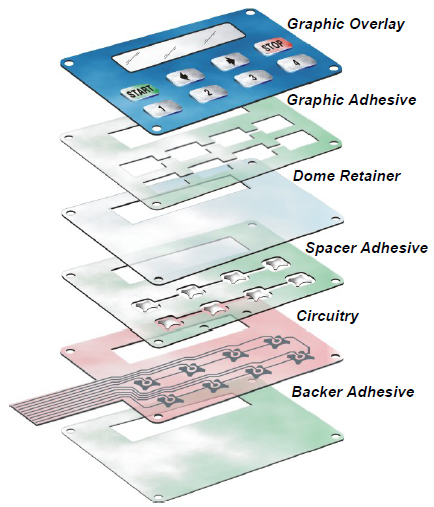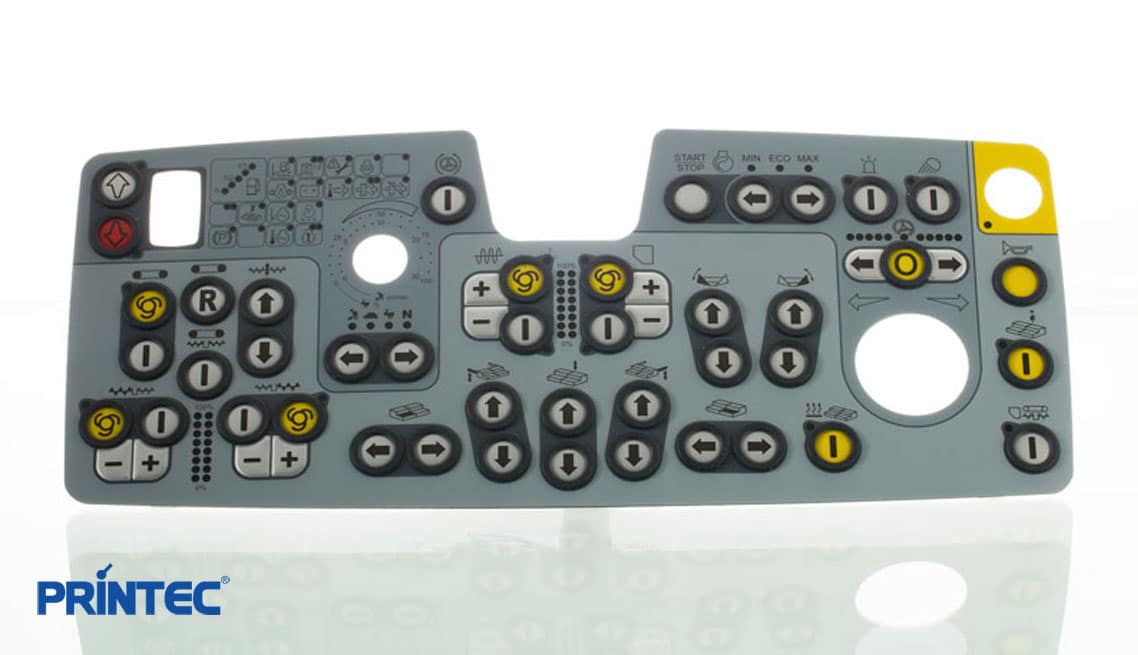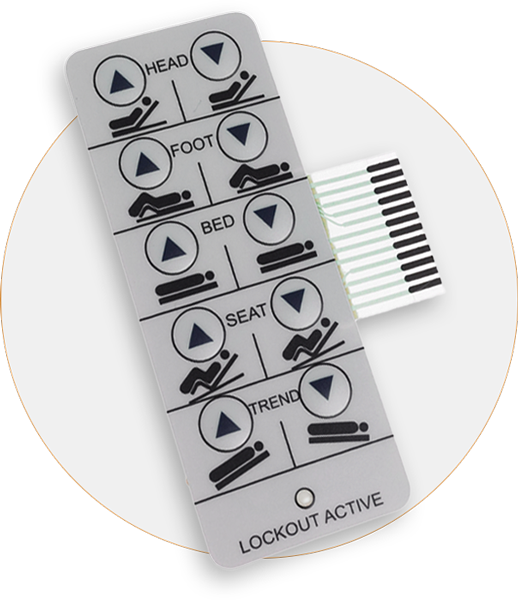Many engineers favor working with a proven membrane switch manufacturer for custom solutions.
Many engineers favor working with a proven membrane switch manufacturer for custom solutions.
Blog Article
Everything About Membrane Layer Switch Over: Recognizing Its Design and Capability
When you consider the control interfaces in contemporary gadgets, membrane buttons commonly enter your mind. These parts are much more than simply switches; they blend layout and capability effortlessly. Comprehending how they function and what makes them efficient can alter your perspective on day-to-day electronic devices. But, there are nuances to their style and efficiency that you might not understand. Let's explore what sets membrane layer switches over aside from other control systems.
What Are Membrane Switches?

Membrane buttons can likewise be customized regarding shape, dimension, and graphics, allowing makers to produce one-of-a-kind user interfaces customized to specific items. In general, membrane layer switches play a significant role in improving customer experience across a large variety of applications.
Just How Membrane Layer Switches Work
When you press a secret on a membrane button, it triggers an uncomplicated yet efficient system. membrane switch manufacturer. The top layer, usually made of adaptable material, presses down onto a conductive layer beneath it.
You'll notice that the tactile responses varies based upon the switch design, using either a soft click or an extra obvious action. When you launch the key, the membrane layer returns to its original position, resuming the circuit and stopping the signal. This procedure occurs nearly immediately, making sure a receptive user experience.
Membrane layer buttons are preferred due to their durability and resistance to dust and wetness, making them suitable for numerous applications, from household devices to clinical gadgets. Understanding this operation assists you appreciate their prevalent usage.
Trick Parts of Membrane Layer Buttons
Comprehending the crucial parts of membrane layer switches is essential for understanding their functionality and layout. The protective layer shields versus ecological variables and put on, expanding the switch's life expectancy. By recognizing these parts, you'll gain insight right into how membrane layer switches over operate and their relevance in different applications.
Materials Made Use Of in Membrane Switch Over Design
The performance and sturdiness of membrane changes heavily depend on the materials made use of in their layout. You commonly come across polyester and polycarbonate as key substratums because of their exceptional toughness and versatility. These products withstand scrapes and chemicals, making them suitable for demanding atmospheres.
The conductive layers typically make use of silver or carbon, picked for their integrity and conductivity. membrane switch manufacturer. Silver offers superior efficiency, while carbon is a cost-effective option. For the overlay, you might take into consideration a matte or shiny coating, relying on your visual needs and customer experience
Adhesives play a crucial role too; they bond layers securely and ensure long life. Make specific to pick adhesives that stand up to environmental aspects like temperature level and humidity. Lastly, don't ignore the significance of an excellent printing strategy for graphics, as it enhances both performance and visual charm. Selecting the best materials will ensure your membrane layer switch stands the test of time.
Layout Factors To Consider for Membrane Layer Switches
While creating membrane layer switches, it's essential to take right Home Page into account numerous factors that influence their performance and customer experience. Start by concentrating on the design and switch dimension; make sure they're intuitive and very easy to navigate. Take into consideration the responsive feedback you want to provide-- will individuals need an obvious click or a softer touch? Additionally, consider the materials you'll make use of, as they'll impact resilience and aesthetics.
Verify your style accommodates ecological factors, like wetness or temperature level variations, which can affect performance. By very carefully thinking about these aspects, you'll create a membrane layer button that enhances use and complete satisfaction.
Applications of Membrane Layer Buttons
Membrane layer switches are flexible elements located in different applications, from commercial tools to consumer electronic devices. You'll see their influence in devices that require resilient interfaces and in tools that take advantage of sleek styles. Recognizing these applications helps you value the performance and functionality of membrane layer switches in daily innovation.
Industrial Equipment Use
When you're looking to boost the capability of industrial devices, membrane layer buttons supply a trustworthy remedy that combines sturdiness with user-friendly design. These buttons are excellent for extreme environments, giving resistance to dirt, wetness, and chemicals. Welcome membrane buttons to streamline your procedures and improve total performance.
Customer Electronic Devices Integration
In the domain of consumer electronics, membrane layer switches imp source play a necessary duty in boosting individual interaction and device capability. You'll find them in tools like go to my site microwaves, push-button controls, and pc gaming consoles, offering a smooth method to connect with modern technology. Their smooth style enables for simple integration right into various items, making controls intuitive and user-friendly. With their capability to incorporate graphics and backlighting, you can enjoy a modern aesthetic that matches the device's general look. Membrane switches likewise assure longevity and resistance to dust and dampness, prolonging the lifespan of your electronics. By choosing membrane layer buttons, you improve not simply the functionality yet additionally the style of your gadgets, making daily communications smooth and pleasurable.
Advantages and Drawbacks of Membrane Layer Switches
While membrane switches offer a series of advantages, they also feature some disadvantages that you need to take into consideration. One significant benefit is their compact design, making them excellent for space-constrained applications. They're likewise economical, supplying a sturdy service with a reduced manufacturing cost. Additionally, their smooth surface area is simple to tidy, enhancing hygiene in settings like medical facilities.

However, there are negative aspects. Membrane layer switches can have a much shorter life expectancy contrasted to mechanical buttons, especially under hefty use. They can also be much less tactile, which could affect user feedback throughout operation. Furthermore, if damaged, repairing them can be difficult and often calls for complete replacement. Eventually, their level of sensitivity to extreme temperatures and environmental problems may restrict their performance in particular setups. Balancing these benefits and drawbacks will aid you identify if membrane buttons are the ideal fit for your job.
Often Asked Concerns
The Length Of Time Do Membrane Layer Changes Generally Last?
Membrane switches over generally last in between 5 to ten years, relying on usage and environmental problems. You'll want to examine aspects like wear, direct exposure to dampness, and temperature level changes to gauge their longevity efficiently.
Can Membrane Changes Be Personalized for Details Layouts?
Yes, you can customize membrane layer buttons to fit certain layouts (membrane switch manufacturer). You'll have the freedom to pick colors, forms, and formats that match your job's needs, ensuring they blend seamlessly with your total visual
What Is the Price Array for Membrane Layer Switch Production?
The expense array for membrane layer switch manufacturing commonly falls in between $1 and $10 per device, depending upon elements like design complexity, quantity, and materials. You can get quotes from producers to find the best choice.

Are Membrane Switches Over Water Resistant or Immune?
Membrane layer buttons can be created to be waterproof or resistant, depending on products utilized and building approaches. If you require them for damp atmospheres, assure you specify those demands during the style process.
Just How Do Membrane Layer Switches Contrast to Standard Switches?
Membrane buttons are usually thinner and much more adaptable than standard switches, using a streamlined layout. They're frequently easier to clean up and incorporate, yet might not supply the tactile comments you're utilized to with mechanical alternatives.
Verdict

Report this page